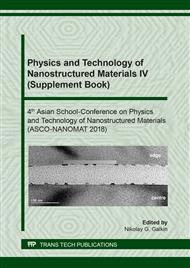[1]
I. Dzyaloshinsky, A thermodynamic theory of weak, ferromagnetism of antiferromagnetics, Journal of Physics and Chemistry of Solids 4 (4) (1958) 241-255.
DOI: 10.1016/0022-3697(58)90076-3
Google Scholar
[2]
T. Moriya, Anisotropic superexchange interaction and weak ferromagnetism, Physical Review 120 (1) (1960) 91.
DOI: 10.1103/physrev.120.91
Google Scholar
[3]
P. W. Anderson, New approach to the theory of superexchange interactions, Phys. Rev. 115 (1959) 2-13.
Google Scholar
[4]
S. Do Yi, S. Onoda, N. Nagaosa, J. H. Han, Skyrmions and anomalous hall effect in a dzyaloshinskii-moriya spiral magnet, Physical Review B 80 (5) (2009) 054416.
DOI: 10.1103/physrevb.80.054416
Google Scholar
[5]
A. Belemuk, S. Stishov, Phase transitions in chiral magnets from monte carlo simulations, Physical Review B 95 (22) (2017) 224433.
DOI: 10.1103/physrevb.95.224433
Google Scholar
[6]
D. P. Landau, K. Binder, A guide to Monte Carlo simulations in statistical physics, Cambridge university press, (2014).
Google Scholar
[7]
V. Y. Kapitan, K. Nefedev, Labyrinth domain structure in the models with long-range interaction, Journal of Nano- and Electronic Physics 6 (3) (2014) 03005-1.
Google Scholar
[8]
P. V. Prudnikov, V. V. Prudnikov, M. A. Menshikova, N. I. Piskunova, Dimensionality crossover in critical behaviour of ultrathin ferromagnetic films, Journal of Magnetism and Magnetic Materials 387 (2015) 77-82.
DOI: 10.1016/j.jmmm.2015.03.075
Google Scholar
[9]
P. S. Rakić, S. M. Radošević, P. M. Mali, L. M. Stričević, T. D. Petrić, Multipath metropolis simulation: An application to the classical heisenberg model, Physica A: Statistical Mechanics and its Applications 441 (2016) 69-80.
DOI: 10.1016/j.physa.2015.08.038
Google Scholar
[10]
G. Brown, T. C. Schulthess, Wang-landau estimation of magnetic properties for the heisenberg model, Journal of applied physics 97 (10) (2005) 477.
DOI: 10.1063/1.1847311
Google Scholar
[11]
K. Chen, A. M. Ferrenberg, D. Landau, Static critical behavior of three-dimensional classical heisenberg models: A high-resolution monte carlo study, Physical Review B 48 (5) (1993) 3249.
DOI: 10.1103/physrevb.48.3249
Google Scholar
[12]
R. Wiesendanger, Nanoscale magnetic skyrmions in metallic films and multilayers: a new twist for spintronics, Nature Reviews Materials 1 (7) (2016) 16044.
DOI: 10.1038/natrevmats.2016.44
Google Scholar


